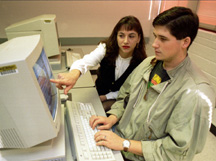 Purdue News
Purdue News
 Purdue News
Purdue News
September 1995

|
The program was established last year with a $100,000 grant from the National Science Foundation and $30,000 from Purdue. Santos spent the first year integrating the program with other campus groups, such as residence halls and the Office of the Dean of Students, and support programs in Purdue's Department of Freshman Engineering.
This fall the program will provide students with on-line mentoring with deaf or hard-of-hearing engineers and scientists. Santos worked with the American Association for the Advancement of Science to identify deaf or hard-of-hearing professionals as potential mentors. By the end of the year, each mentor will have his or her own home page on the World Wide Web, Santos says.
"We hope to have about 50 professionals in the fields of math, science and engineering available to students at Purdue," she says. "By electronically communicating with deaf or hard-of-hearing professionals, students won't have to reinvent the wheel when they come to school. They'll be able to ask questions and get honest answers from people familiar with the challenges unique to deaf and hard-of-hearing students.
"It's not just a bunch of hearing people telling deaf students what they can do - it's advice from deaf people who are already out there doing it. That will change attitudes, and that's what the program is all about." Santos also participates in discussion groups on the Internet, both to inform potential students and parents about Purdue's program and to learn about the concerns of the deaf and hard of hearing.
Santos says most science and engineering programs for deaf or hard-of-hearing students are located at colleges or universities specifically for the deaf, but Purdue's program will attempt to mainstream those students. "We want to help them learn to integrate with the hearing community while they're in college instead of waiting until they get on the job, where it may be more difficult," she says.
For example, Santos will work one-on-one with students to prepare them for Purdue's cooperative education program, where students alternate semesters of job experience with classes.
"Some of them may not know how to talk about their special needs, or where they can get special accommodations," she says. "Through role-playing, we can work through those issues."
The program also will provide deaf and hard-of-hearing students with stenographers and real-time speech-to-text translation equipment that instantaneously translates a stenographer's shorthand into English on a computer screen. This system allows a deaf user to read what is being said during lectures as well as what is being written on the board without losing any information.
"In highly technical fields such as engineering and science, traditional interpreters may not be as effective in conveying information because of problems dealing with technical jargon," Santos says. "So deaf or hard-of-hearing students in these fields may have limited interaction in class due to their inability to completely follow the lecture and discussion."
The stenographers and computers are offered in addition to the note-takers and sign or oral interpreters normally provided to deaf or hard-of-hearing students through the Office of the Dean of Students. Oral interpreters, available to students who may not communicate using sign language, communicate classroom discussion to deaf or hard-of-hearing students by repeating lectures without using their voice as the student reads the interpreter's lips.
Santos also has worked with residence hall personnel to ensure that accommodations such as close-captioned televisions are in place. In addition to providing oral and sign interpreters to clubs, Santos also encourages student organizations to provide on-line access to call-out information. The Deaf and Hard of Hearing in Engineering Program begins its recruitment phase this fall, and Santos says she expects all services to be in place by January.
As part of the recruitment efforts, Santos is working with the Indiana Department of Special Education to identify deaf and hard-of-hearing high-school students interested in math and science.
"Special education cooperative offices provide individual educational plans for deaf and hard-of-hearing students in each county," Santos says. "These offices are part of the state's initiative to raise the level of service to students with special needs in the educational process. We're working with those offices as well as residential schools for the deaf in Indiana and about five other Midwestern states."
Last year, approximately 75 deaf or hard-of-hearing students were enrolled at Purdue.
PHOTO CAPTION--Carol Santos, director of Purdue University's Deaf and Hard of Hearing in Engineering Program, works with freshman engineering student Tim Stough to create a page on the World Wide Web. Through Santos' program, deaf or hard of hearing students majoring in engineering will use the Internet to communicate and network with professional engineers who are also deaf or hard of hearing. The mentoring program is one of several services Purdue offers. (Purdue News Service Photo/David Umberger)
Color photo, electronic transmission, download available here. Photo ID: Santos/Deaf
NOTE TO JOURNALISTS: The Deaf and Hard of Hearing Web Page is located at: https://dhhe.www.ecn.purdue.edu/DHHE/
aas/santos/9509f5
Source: Carol L. Santos, (317) 494-0836;
Internet, deafengr@ecn.purdue.edu;
Writer: Amanda Siegfried, (317) 494-4709; home, (317) 497-1245;
Internet, amanda_siegfried@purdue.edu